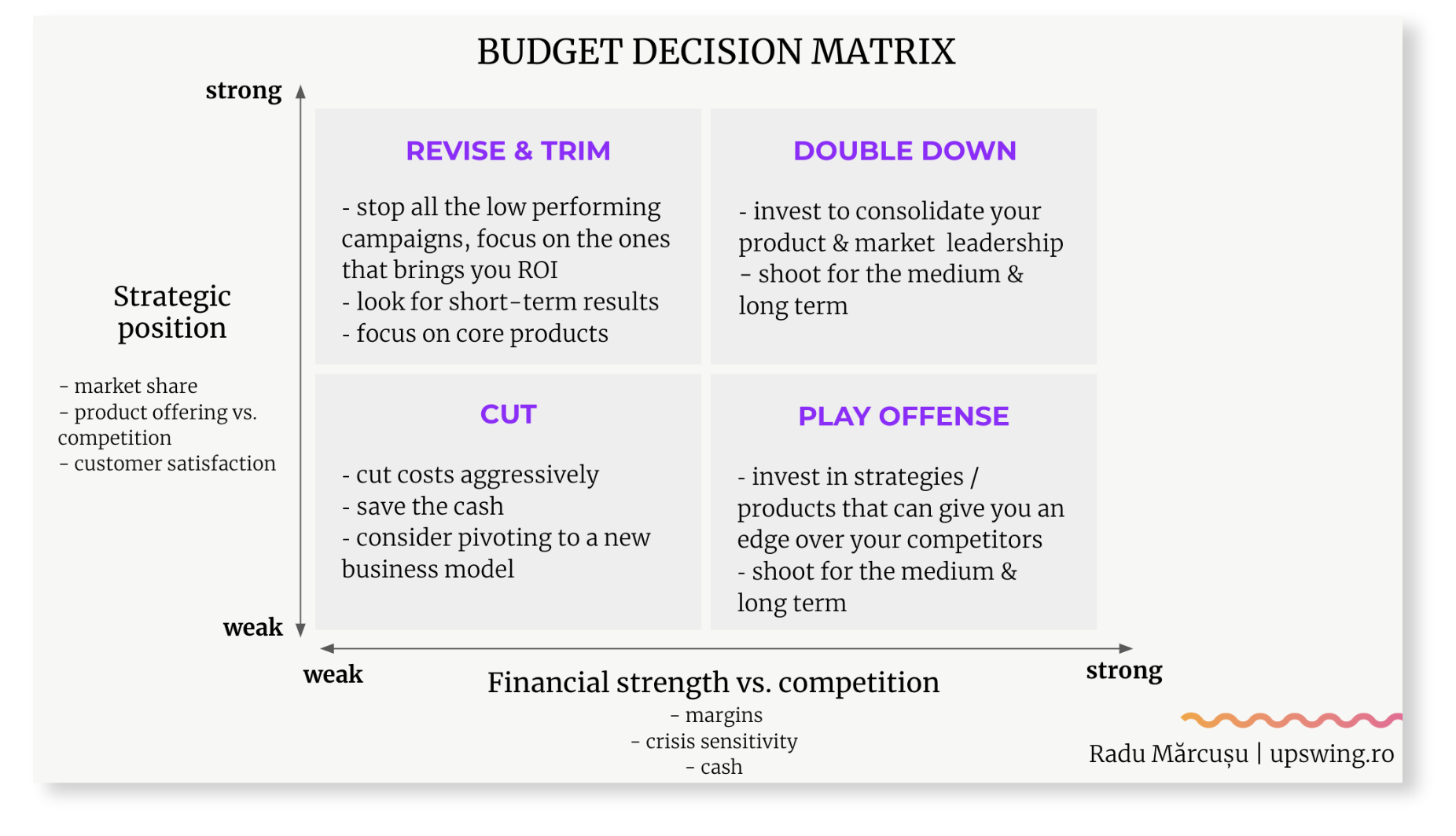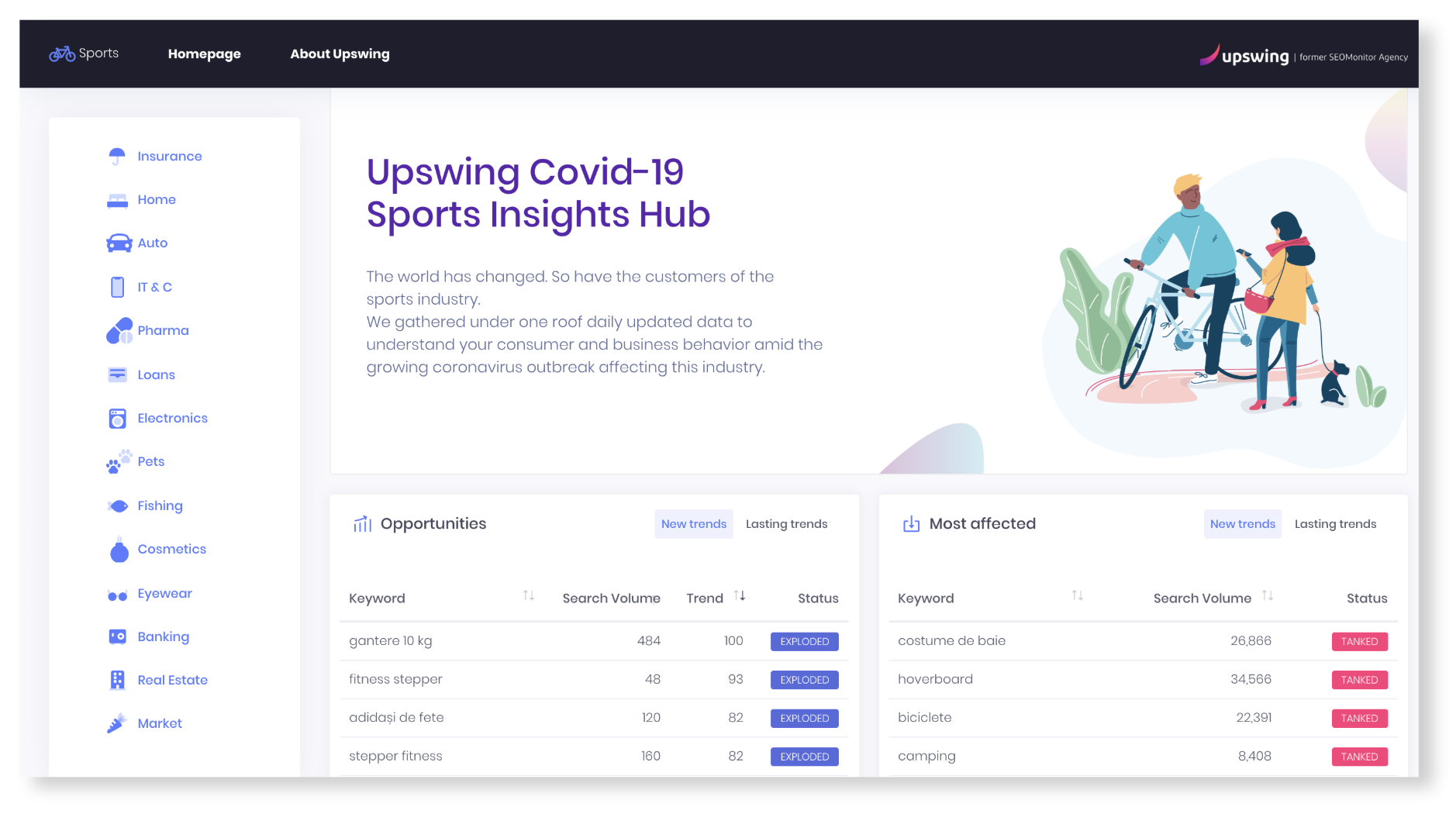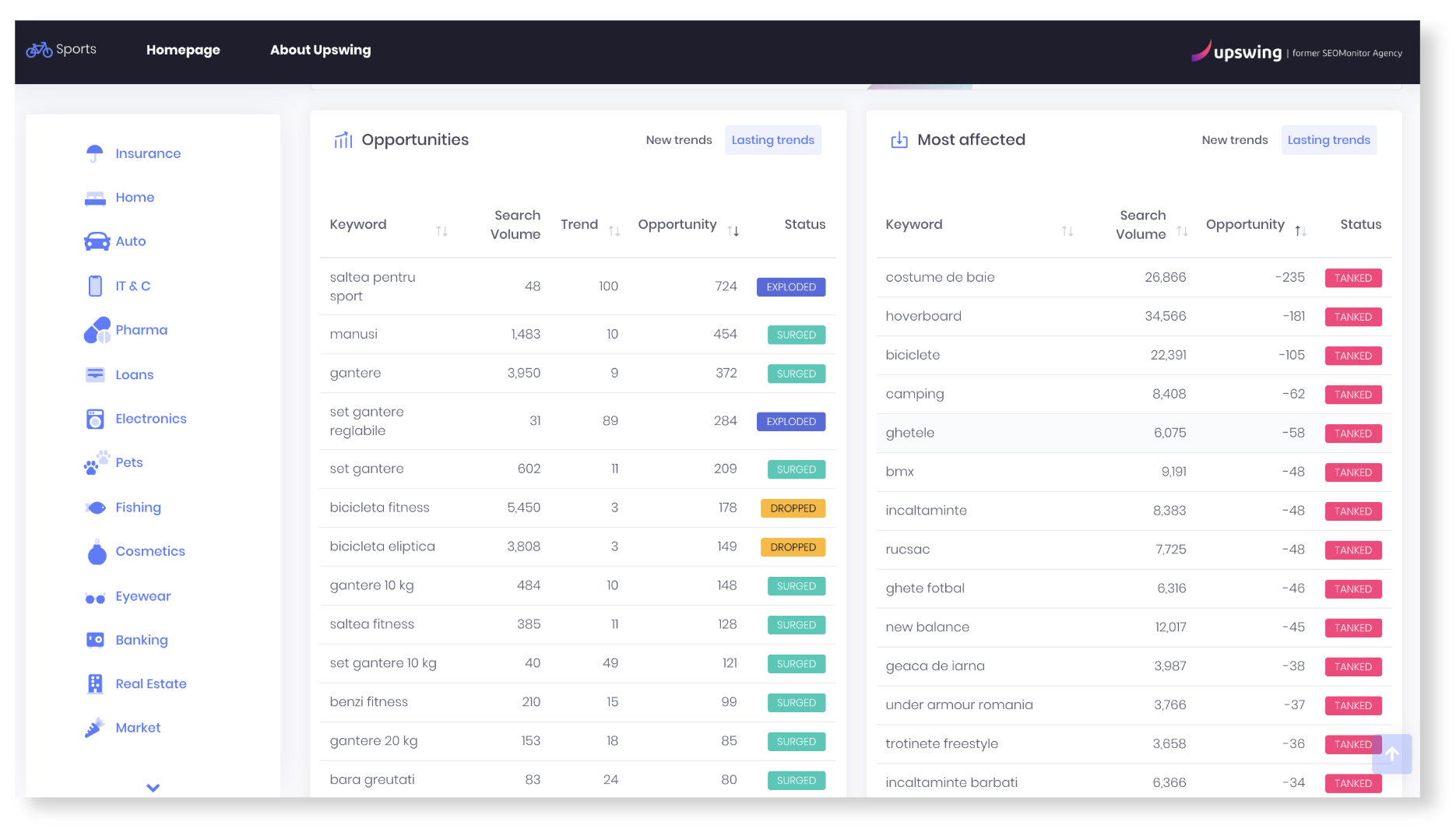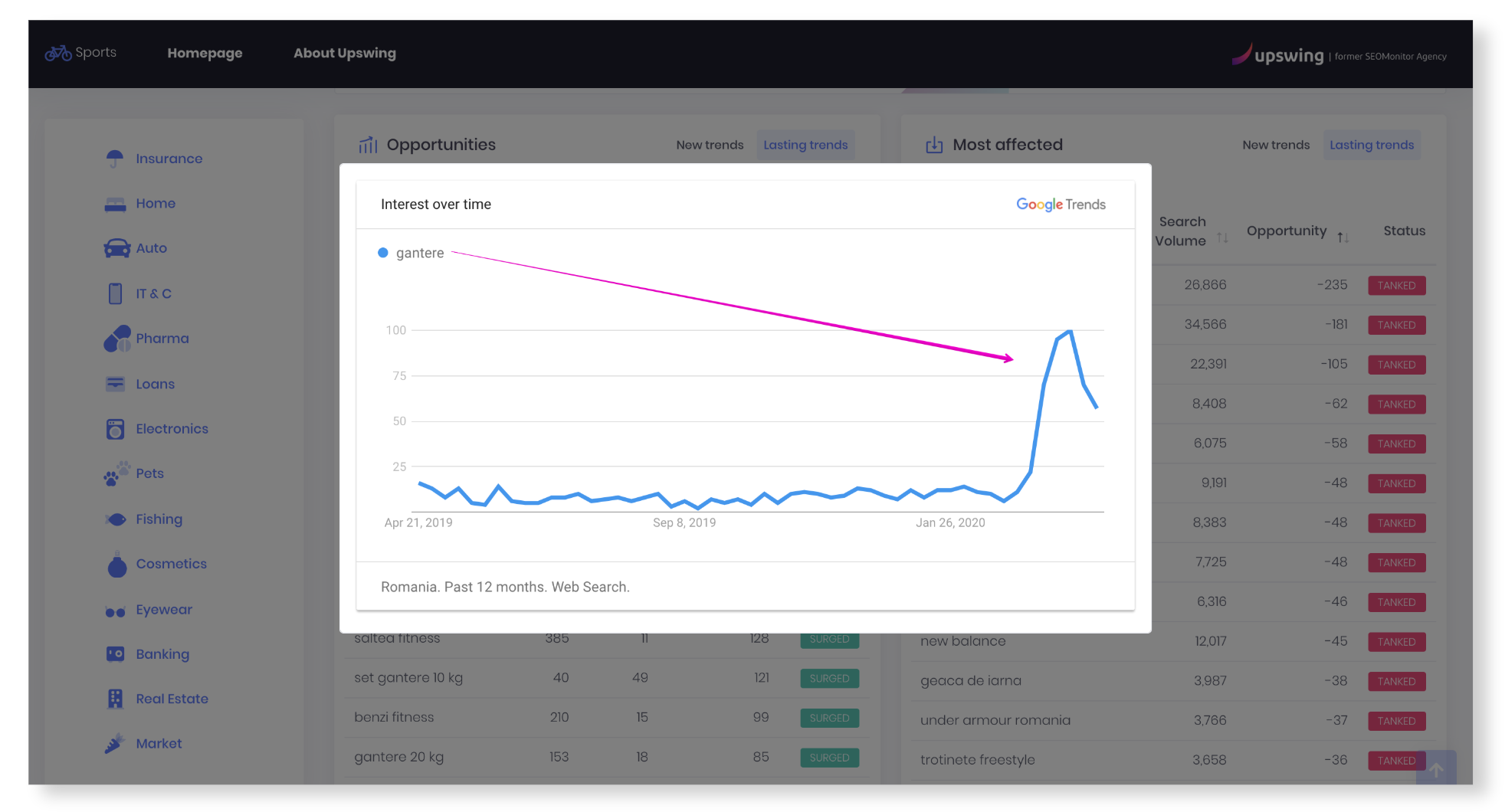Starting from the premise that no crisis should be wasted, we gathered our expertise resources and put them together in a webinar addressed to all businesses that want to emerge victorious from this struggle that we all lead. If you haven’t watched it live, we’ll give you a summary below or you can watch the recording.
Because we all need solutions when circumstances force us to make drastic decisions. Because we need to act quickly and use all available tools to align with change. Because we need to get to know those who consume our products and services again – because their needs have changed. And because, yes, we need to reduce spending in segments that do not add value to us and direct them to new opportunities. And how do we do this accurately, if not based on real-time data?
You can stagnate in this crisis or you can win. What do you choose?
Budget decision matrix
Depending on the availability of marketing budgets, there are 4 possible scenarios, in terms of strategic positioning (market share, product offering compared to competition and customer satisfaction) and financial strength (profit rate, crisis sensitivity and cash flow):
 Poor strategic positioning and weak financial strength
Poor strategic positioning and weak financial strength
Drastically reduce costs to keep cash; one solution could be to pivot the business model.
Strong strategic positioning and weak financial strength
Stop underperforming campaigns and focus on the ones that bring you ROI; keep your focus on commodities basic products and act to get short-term results.
Poor strategic positioning and high financial strength
Invest in strategies and products that give you a competitive advantage; seek to achieve results in the medium and long term.
Strong strategic positioning and high financial strength
Invest to strengthen your market position and focus on getting medium and long term results.
Regarding the stages in which you will act, there are 3 important moments in the chronology of business evolution:
- Adaptation, which involves adjusting costs and implementing a short-term strategy during the pandemic.
- The online transition, in which the medium-term strategy is established, with the related marketing actions.
- The new post-crisis normalcy, which comes with a long-term strategy and marketing and content marketing campaigns with clear objectives.
Marketing principles to guide you during this period:
- Be brave and act fast.
- Reassess your audiences and deliver according to their needs and expectations.
- In everything you do, take into account the socio-economic context.
- Rely on real-time data to adjust your plans.
- Don’t miss your short-term opportunities, without neglecting the long-term ones.
- Rely on the agility of push promotion (Facebook) and did not just wait for the results from pull marketing (Google).
If you want to know more about the principles that guide us to Upswing during this period, read about our new methodology.
How we created a tool based on real-time data to better understand consumers’ needs and respond to them on time
Because we at Upswing are in a position to re-evaluate processes and strategies, we wanted to understand, first of all, what our customers’ needs are during this period. Because only in this way we can adapt quickly and help them count not among the survivors, but among the winners of this crisis.
We noticed that people’s emotions and, implicitly, their interests are constantly changing during this period. And that year-over-year data, on which the entire SEO & content industry relied, is losing relevance in unstable circumstances. That’s why we created Upswing COVID-19 Trends, a free tool integrated with Google Trends, which reflects, through real-time data, consumer interest in 100k keywords analyzed in 25 industries.

Here’s what you can find here:
Opportunities – New trends, you will see the words whose interest has increased in the last 3 days, compared to the week before the start of the pandemic (February 24 – March 1).
Opportunities – Lasting trends, you will see the words whose interest has increased in the last week, compared to the average of the last 12 months.
Most affected shows you those searches that followed a downward trend, for the same periods as above.
How we use this data to adapt
In the absence of the patterns we could use before the pandemic broke out, these data are currently our only resource for adapting our business to the new demands of the market. Here is what this consists of and how you can replicate our steps to adapt to the new context:
Realistic financial forecasts
Uncertainty has taken over the financial environment. However, the data that indicates your search trends can be used in the forecasting methodology. Of course, caution should be first when it comes to these, but reporting on emerging trends in business plan development can bring more transparency.
Procurement strategy in line with stocks
Because optimizing the products on the site that will disappear from stock would be a waste, with the help of the data you have the opportunity to predict trends and replenish your reserves, to meet demand. On the other hand, the downward trends will indicate the products for which there is no demand and for which you can make decisions to cancel purchases, return – if possible or apply promotional prices.
Aligned content
The content of the website must be aligned with the current conditions. Here’s what you can do:
Creating new categories in the site
Consumers now have specific needs, to which you must respond articulately. Thus, creating new categories on the site that intuitively take users to the products they need can bring you benefits.
For example, in the category of sports equipment, the search for “dumbbells” and other similar accessories is constantly increasing, as consumers are now limited to moving around in their own homes. Thus, the data reveals the opportunity to offer them exactly the products they need, by creating a new category on the site.
Internal linking
The pages of products or categories with potential in this period can benefit from an increased authority, if you do internal linking to highlight them. Add categories or subcategories that have an upward trend during this period in the main menu of the site to send authority but also to facilitate user access.
Aligning the SEO strategy with the PPC one
Aligning all marketing messages to the new orientation and coordinating the PPC strategy with the SEO one or customizing the cross- or up-sell feeds will support the business objectives set for this period.
Pivoted content strategy
The results of the content developed and promoted strictly through pull marketing (Google) bring results in rankings only after 1-3 months. But time is running out now. During this time, information can become irrelevant and businesses can disappear in the darkest scenarios. Therefore, the focus of the promotion strategy must now also include push marketing (Facebook). In this way, businesses can proactively address their customers to meet their needs promptly.
Tip: Current data can help you re-evaluate the categories of buyer persona you are targeting. Upswing COVID-19 Trends shows you the most searched products, and from the internal reports and those in Analytics you will be able to extract data that show you the unusual patterns of searches and their evolution before the onset of the crisis and until now.
Adjust existing content
Google Search Console tells us what content we can generate or improve. We audit the content of the site and check if it can be updated with information that consumers are looking for during this period.
Fostering the relationship with loyal customers through transparent communication
Customers’ expectations are proportional to their attachment to brands. That’s why old customers need transparency more than anyone else. The best way to reach them and reassure them that they have made the right choice for your business is to manage this crisis through open and honest communication. This means that your messages about how the brand feels about this experience must be honest and consistent.
Show them that they can rely on your support and expertise as much as they can on the products and / or services you offer.
Other resources that guide our actions
Upswing COVID-19 Trends is, in itself, an indicator of the impact that COVID-19 has on search trends. In addition to this, however, we also use other tools to make the best marketing decisions for our customers:
Google Analytics Revenue
We have developed dashboards in Google Data Studio, which show us what impact the current situation has on customer sales. For an overview, we compared the data with those before the crisis, but also with the same period last year (year-over-year).
Internal searches
In a custom Dashboard we display data from the internal search of customer sites, to find unusual patterns of pre- and post-crisis onset (March 8-10). These data helped us decide which subcategories should be generated and promoted.
Google Search Console
We follow in the Google Search Console the evolution of pre- and post-crisis impressions. Thus, we discover which are the categories of client sites that we did not focus on SEO campaigns, but which have a greater potential now. Transactions in Google Analytics, while not providing such data, can give new directions for strategy.
The webinar recording will reveal more insights into how we manage things at Upswing in the context of the pandemic and the discoveries we have made. In the meantime, access Upswing COVID-19 Trends for free, for real-time data that will help you provide consumers with what they need and adapt your business quickly, efficiently and with a clear goal: to emerge victorious from the crisis.





